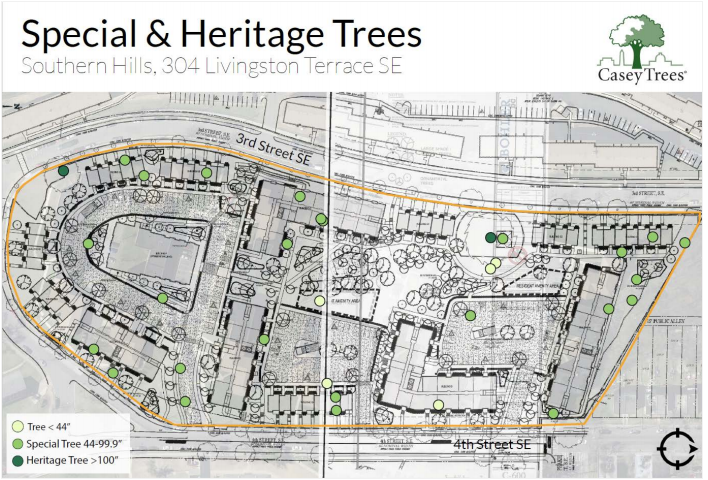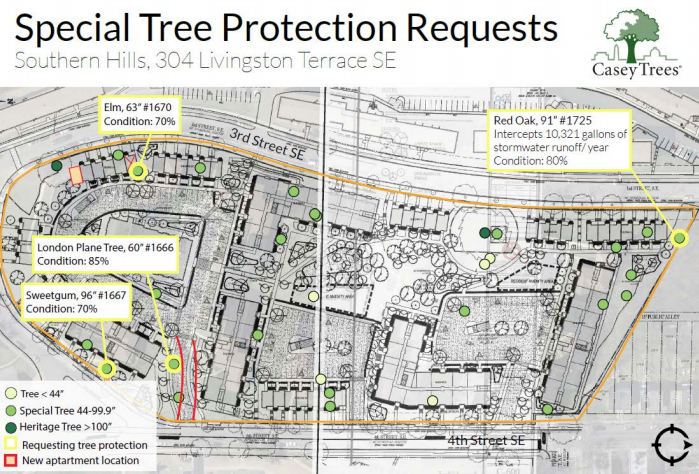Southern Hills Testimony
Testimony of Kristin Taddei, Planning Advocate, Casey Trees
September 19, 2018
Before the Board of Zoning Adjustment on Redevelopment of 304 Livingston Terrace SE
BZA Case No. 19819: Southern Hills LP
Good morning board members,
My name is Kristin Taddei and I am the Planning Advocate with Casey Trees. As you may know,
Casey Trees is a Washington, D.C.-based nonprofit with a mission “to restore, enhance, and
protect the tree canopy of the nation’s capital.” To fulfill this mission, we plant trees; monitor
the city’s tree canopy; and work with decision makers, developers, and residents to encourage
tree planting and protection. We are dedicated to helping the District reach its 40 percent tree
canopy goal by 2032. As a city, we will achieve this goal with sustainable development projects
that protect existing trees and achieve a net gain in tree canopy.
We have been in touch with the development team regarding the 24 Special Trees and 2
Heritage Trees at Southern Hills. Our goal is to ensure that mature, healthy trees are preserved
where possible, and that the level of tree canopy after development exceeds the tree canopy
that exists today, so that as a city, we continue to get closer to 40% tree canopy.
We were pleased to hear that the development team has the support of the community for this
project, and that residents will be able to remain in their current homes until new housing is
available. We also understand that this phased plan makes it difficult to preserving existing trees
in some cases.
At a site visit on August 8, 2018, the development team shared their plans to protect the critical
root zone of the two Heritage Trees on this property (Figure 1). They have taken exceptional care
to do so, and we are impressed by the steps they have taken in this case. In addition, our
independent analysis shows that once trees in the landscaping plan reach maturity, tree canopy
will more than double on this site (Figure 2). These trees will provide a valuable community
amenity; add privacy to the homes of current residents; and help to manage pollution, flooding,
and erosion on this hilly site.
We do have four requests that we would like to bring to the BZA today. Our intent is not to delay
this project – we understand that residents and the development team would like this project to
move ahead quickly. Rather, we would like to request two small plan modifications and two
commitments before the BZA moves to approve this project:
-
- We believe it would be possible to relocate one of the proposed units along 3rd Street SE
in Building G6. This modification would allow the development team to preserve Special
Trees #1670 – an elm tree in very good condition (Figure 3). - In addition, slightly changing the orientation of the parking lot entrance from 4th Street SE
would allow the development team to retain Special Tree #1666 – a London plane tree
with a very high 85% condition rating (Figure 3). - We also believe it would be possible to protect Special Tree #1667 – a sweetgum tree
with a 70% condition rating – which falls in green space near the intersection of 4th Street
SE and Livingston Terrace SE. We would like to request that the development team
commit to protecting this tree using metal tree protection fencing and signage per
DDOT’s tree protection requirements (DWG No. 608.10) (Figure 3). - Finally, we would like to request protection of Special Tree #1725 – a very large, healthy
red oak with an 80% condition rating – which is at the very edge of the property near 3rd
Street SE. The development team plans to install bioretention near this tree. Retaining
this tree, which is currently intercepting over 10,000 gallons of stormwater per year, will
only strengthen this robust stormwater management plan (Figure 3).
- We believe it would be possible to relocate one of the proposed units along 3rd Street SE
Taking these actions would add roughly 5,000 square feet of shaded green space. Even though
we are only requesting that 4 of the 24 Special Trees on this property be retained, we urge the
development team and the BZA to consider these trees a significant community benefit.
I would also like to note that over the past month, the development team committed to
including trees in rain gardens/bioretention where possible and consulting with Casey Trees
when determining tree species to be planted to create a diverse palette of trees that increases
resilience to temperature fluctuations and disease.
Again, we do not want to delay the project and are happy there is community support. We are
appreciative of the developer’s openness to input and the commitments they have made
throughout this process, and we look forward to the BZA’s review of the three requests outlined
above. We are confident that if our suggestions are implemented, this development will be a
shining example of an environmentally conscious design that also meets the needs of this
community.
Thank you for the opportunity to testify.

Figure 1. There are currently 24 Special Trees and 2 Heritage Trees at Southern Hills. The development team
plans to protect the critical root zone of the two Heritage Trees on this property.

Figure 2. Our independent analysis shows that once trees in the landscaping plan reach maturity, tree canopy
will cover an estimated 29% of the property, compared to 12% today. For the purposes of this analysis, the
canopy of a mature canopy tree was considered 35’ in diameter and 90 m2 area, and the canopy of a mature
ornamental tree was considered 15’ in diameter and 16 m2 area.

Figure 3. Protecting the 4 Special Trees circled in yellow by relocating one apartment building, changing the
orientation of the parking lot entrance from 4th Street SE, and implementing tree protection measures would
add roughly 5,000 square feet of shaded green space.